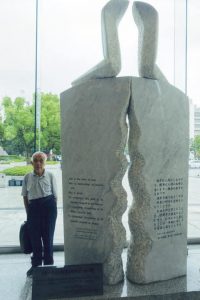My Life — Interview with Hiromu Morishita (1930–), A-bomb survivor and teacher, Part 13: Role as calligrapher
May 6, 2022
weight:bold;">Anti-nuclear hopes incorporated into calligraphy work
In 1990, Hiromu Morishita retired as a teacher at Hiroshima Prefectural Hatsukaichi High School. The same year, he began teaching calligraphy as a professor at Shimane University, and in 1995, at Hiroshima Bunkyo Women’s University (present-day Hiroshima Bunkyo University, located in the city’s Asakita Ward.
I taught at the universities until I was 70. I still teach calligraphy at my home, and exhibit my calligraphy work twice a year at exhibits held by a group to which I belong under the pseudonym Seikaku Morishita. I received the “Kaku” part of that name from my first calligraphy teacher.
The world of calligraphy is deep and complex. I’m still only halfway to where I want to be. Unlike painting, the calligraphy world is a simple one of black and white. The flow of the lines and the arrangement of the characters… I cannot quite reach a level I think is perfection. My physical strength is on the decline, and I tire easily. However, when I come across poetry I want to express in calligraphy, things turn out. Naturally, many of my works deal with the atomic bombings. My work selected for the Japan Fine Arts Exhibition in 1969, “A charred boy lying under a guardrail like an earthworm expresses no pain,” was one of those. That was a scene I witnessed near Nigitsu Shrine (in Hiroshima’s Higashi Ward) on the day of the atomic bombing.
I have also been commissioned to write calligraphy for a number of monuments. One is the Pope John Paul II “Appeal for Peace” monument in the Hiroshima Peace Memorial Museum (located in the city’s Naka Ward). His appeal began with the words “War is the work of man.” In 2011, the year before I resigned as chair of the World Friendship Center, a position in which I had served for 26 years, we erected a monument to the late Barbara Reynolds near Peace Memorial Park (also in Naka Ward). The inscription on the monument reads, “I, too, am a Hibakusha.” I inscribed her words on the monument. I would like everyone to know that she was someone who loved Hiroshima and continued to be sympathetic to the suffering of the A-bomb survivors.
I also respect several of the members of the Japan Confederation of A- and H-Bomb Sufferers Organizations (Nihon Hidankyo). One of them was Ichiro Moritaki, former co-chair of the organization who died in 1994. I empathized with his stance of carrying out sit-ins each time a nuclear test was conducted, and there were even times when I sat next to him. Alongside Mr. Moritaki, I attended the 2nd Special Session on Disarmament of the U.N. General Assembly held in New York in 1982.
Because of my involvement in peace education, I did not join the Hidankyo organization. However, whenever there was an opportunity, I collaborated with the group because I could learn from them. I often participated in the World Conference against Atomic and Hydrogen Bombs. Even after the movement split into two because of differences in political ideology, and the Japan Council against Atomic and Hydrogen Bombs and the Japan Congress Against A- and H-Bombs began to hold conferences separately, I attended both organizations’ gatherings. The differences in ideology do not matter. I want to do everything I can for the sake of peace. That has been my thinking about the issue.
(Originally published on May 6, 2022)








